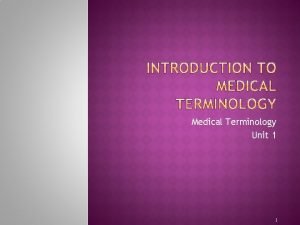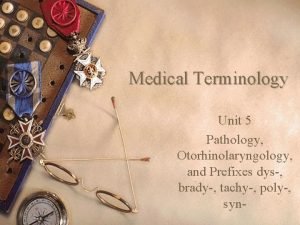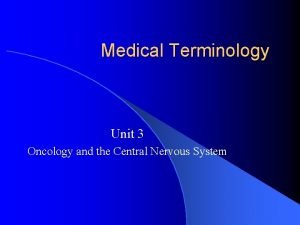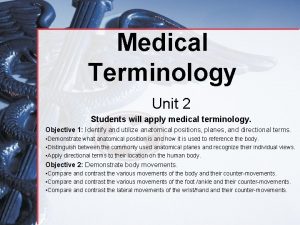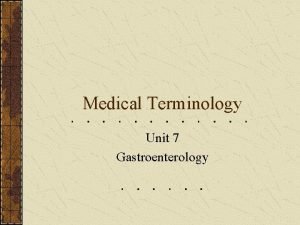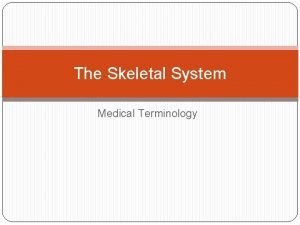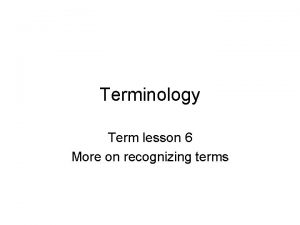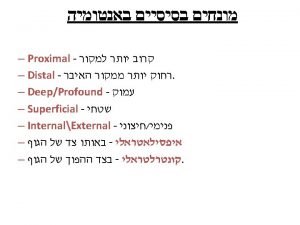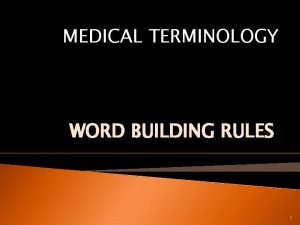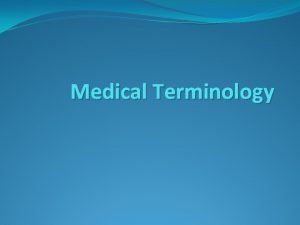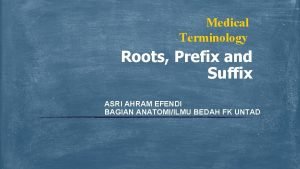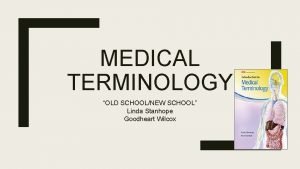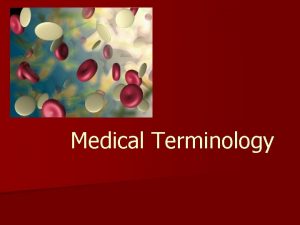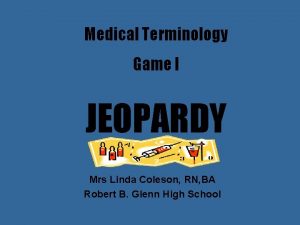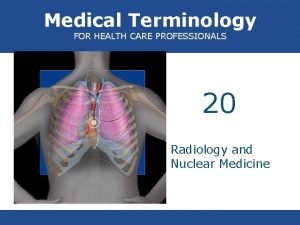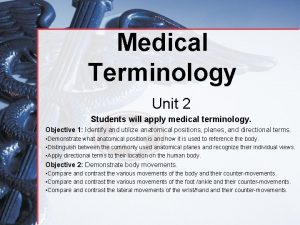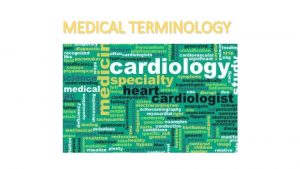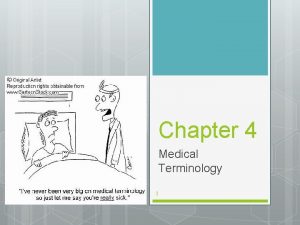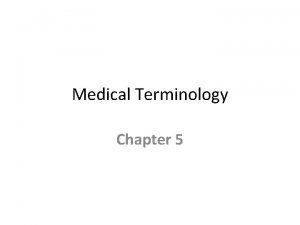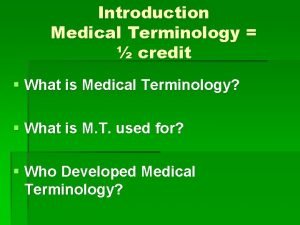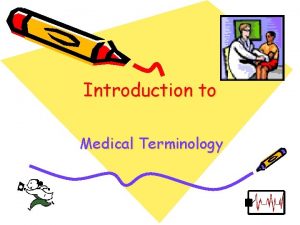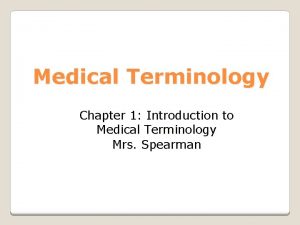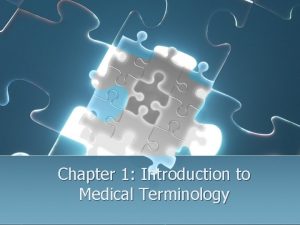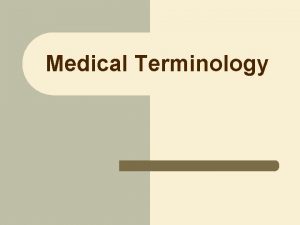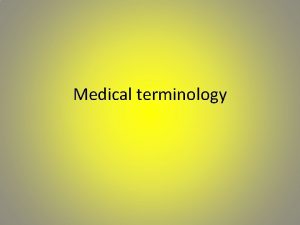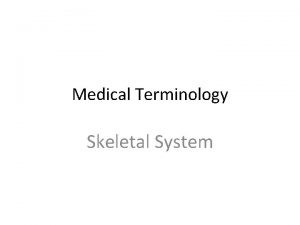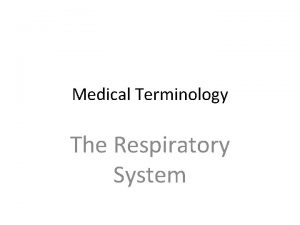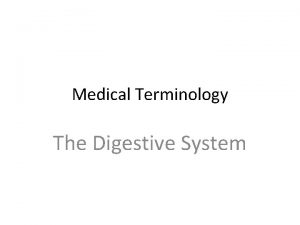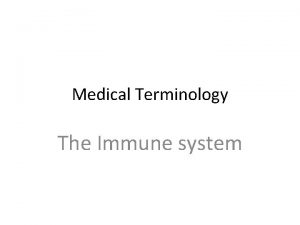Medical Terminology Unit 2 Students will apply medical





























- Slides: 29

Medical Terminology Unit 2 Students will apply medical terminology. Objective 1: Identify and utilize anatomical positions, planes, and directional terms. • Demonstrate what anatomical position is and how it is used to reference the body. • Distinguish between the commonly used anatomical planes and recognize their individual views. • Apply directional terms to their location on the human body. Objective 2: Demonstrate body movements. • Compare and contrast the various movements of the body and their counter-movements. • Compare and contrast the various movements of the foot /ankle and their counter-movements. • Compare and contrast the lateral movements of the wrist/hand their counter-movements.

Anatomical Terms Worksheet

History • During the Renaissance (“Rebirth”) the study of human life and medicine began to flourish. • Scientist, Doctors and Artist would experiment and practice on the dead and incarcerated. • Cadavers were positioned flat on their backs, thus making it easier to draw and reference from that position. • Many artist such as Leonardo da Vinci began to study, draw and diagram the human body.

Anatomical Position • Standing erect, with palms and feet facing forward • Is the standard reference point in which all positions, movements, and planes are described

Anatomical Planes • Fixed lines of reference along which the body is often divided or sectioned to facilitate viewing of its structures • Allow one to obtain a three-dimensional perspective by studying the body from different views

Anatomical Planes Sagittal plane • The plane dividing the body into right and left portions • Midsagittal or median are names for the plane dividing the body into equal right and left halves

Anatomical Planes Frontal plane • The plane dividing the body into front and back portions • Also called the Coronal plane

Anatomical Planes Transverse plane • The horizontal plane dividing the body into upper and lower portions • Also called the Horizontal plane

Positions and Directions Terms of position and direction describe the position of one body part relative to another, usually along one of the three major body planes

Positions and Directions Superior • Refers to a structure being closer to the head or higher than another structure in the body Inferior • Refers to a structure being closer to the feet or lower than another structure in the body

Positions and Directions Anterior • Refers to a structure being more in front than another structure in the body Posterior • Refers to a structure being more in back than another structure in the body

Positions and Directions Medial • Refers to a structure being closer to the midline or median plane of the body than another structure of the body Lateral • Refers to a structure being farther away from the midline than another structure of the body

Positions and Directions Distal (Reference to the extremities only) • Refers to a structure being further away from the root of the limb than another structure in the limb Proximal (Reference to the extremities only) • Refers to a structure being closer to the root of the limb than another structure in that limb

Distal / Proximal Cont. • When you divide the skeleton into Axial (Blue) and Appendicular (Yellow) you can better understand the extremities and their roots. Proximal Distal

Positions and Directions Superficial • Refers to a structure being closer to the surface of the body than another structure Deep • Refers to a structure being closer to the core of the body than another structure

Positions and Directions Ventral • Towards the front or belly • You Vent out or your nose and mouth. Dorsal • Towards the back • Like the Dorsal fin of a dolphin.

Humans are bipedal, we walk on two legs, therefore our Ventral side / Dorsal side flips at our lower extremities. Ventral – Black Dorsal – White

Positions and Directions Prone • Lying face down • Like a Pro Baseball player sliding into Home. Supine • Lying face up • Lying on your spine and you can have soup poured into your mouth. Unilateral • Pertaining to one side of the body Bilateral • Pertaining to both sides of the body

Movements • • • • • • Flexion Extension Hyperextension Adduction Abduction Prontaion Supination Retraction Protraction Elevation Depression Rotation Circumduction External Rotation Inversion Eversion Dorsiflexion Plantarflexion Radial Deviation Ulnar Deviation Opposition

Movements Flexion • Bending a joint or decreasing the angle between two bones • In the Fetal Position we are flexing our joints Extension • Straightening a joint or increasing the angle between two bones • In the Anatomical Position we are extending our joints Hyperextension • Excessive extension of the parts at a joint beyond anatomical position.

Flexion / Extension / Hyperextension

Movements Adduction • Moving a body part towards the midline of the body Abduction • Moving a body part away from the midline of the body

Movements Pronation • Turning the arm or foot downward • (palm or sole of the foot down) • Prone Supination • Turning the arm or foot upward • (palm or sole of the foot - up) • Supine

Movements Retraction • Moving a part backward Protraction • Moving a part forward Elevation • Raising a part Depression • Lowering a part

Movements Rotation • Turning on a single axis Circumduction • Tri-planar, circular motion at the hip or shoulder External rotation • Rotation of the hip or shoulder away from the midline Internal rotation • Rotation of the hip or shoulder toward the midline

Movements Lateral Flexion • Side-bending left or right

Movements of the Foot Inversion • Turning the sole of the foot inward Eversion • Turning the sole of the foot outward Dorsiflexion • Ankle movement bringing the foot towards the shin Plantarflexion • Ankle movement pointing the foot downward

Movements of the Wrist & Thumb Radial Deviation • Movement of the wrist towards the radius or lateral side. Ulnar Deviation • Movement of the wrist towards the ulna or medial side. Opposition • Movement of the thumb across the palm of the hand.

Additional Range of Motion
 Cross apply vs outer apply
Cross apply vs outer apply Unit 1 medical terminology worksheet answers
Unit 1 medical terminology worksheet answers Fast medical term
Fast medical term Ser medical term prefix
Ser medical term prefix Medical terminology unit 2
Medical terminology unit 2 Medical terminology for teeth
Medical terminology for teeth What image did rizal carved on a piece of batikuling?
What image did rizal carved on a piece of batikuling? Unit 6 review questions
Unit 6 review questions Chapter 11 medical terminology
Chapter 11 medical terminology Medical terminology skeletal system
Medical terminology skeletal system Erect position
Erect position Lesson 6 medical terminology
Lesson 6 medical terminology Medical terminology lesson 12
Medical terminology lesson 12 What is a suffix in medical terminology
What is a suffix in medical terminology Rrhea medical term
Rrhea medical term Nose prefix medical
Nose prefix medical Khan academy medical terminology
Khan academy medical terminology Medical terminology pronunciation rules
Medical terminology pronunciation rules Mammogram medical terminology
Mammogram medical terminology Ophthalmology medical terminology
Ophthalmology medical terminology Pyel medical terminology
Pyel medical terminology Contrasting prefixes medical terminology
Contrasting prefixes medical terminology Gastroenteritis suffix
Gastroenteritis suffix Medical terminology lesson plans
Medical terminology lesson plans Basic medical abbreviations
Basic medical abbreviations Suffix phylaxis
Suffix phylaxis Medical terminology
Medical terminology Medical term colors
Medical term colors Jeopardy medical terminology
Jeopardy medical terminology Mammogram medical terminology
Mammogram medical terminology

